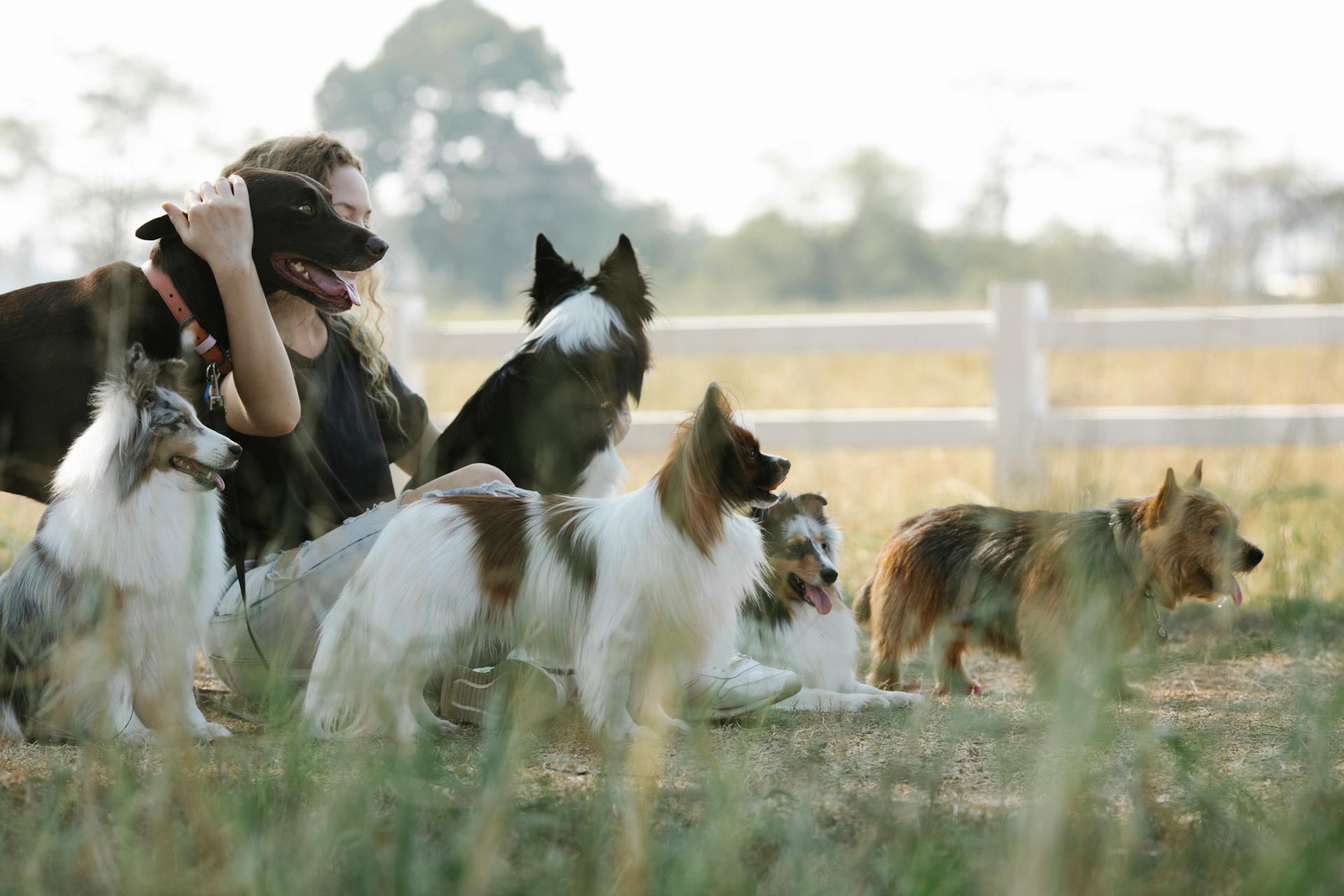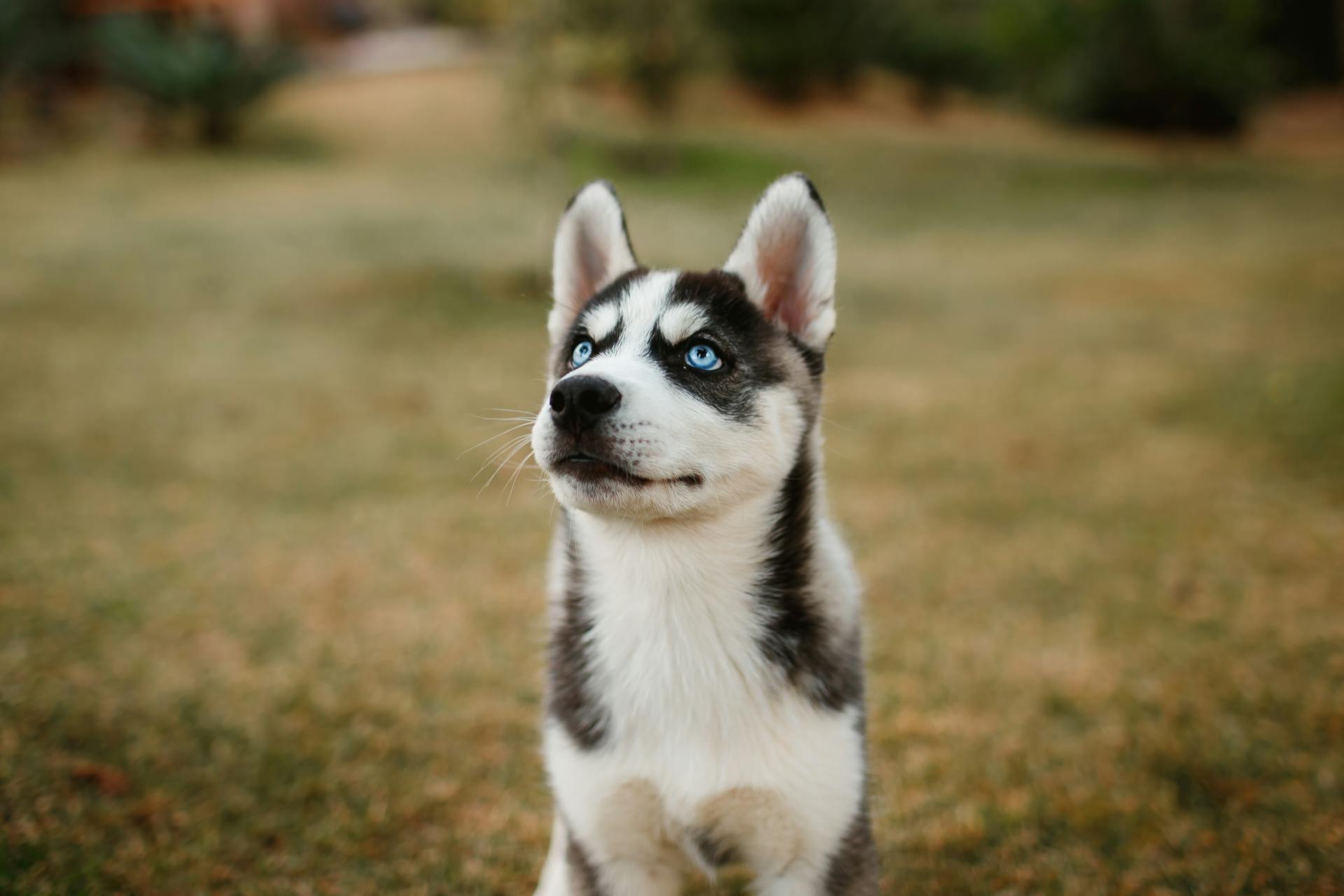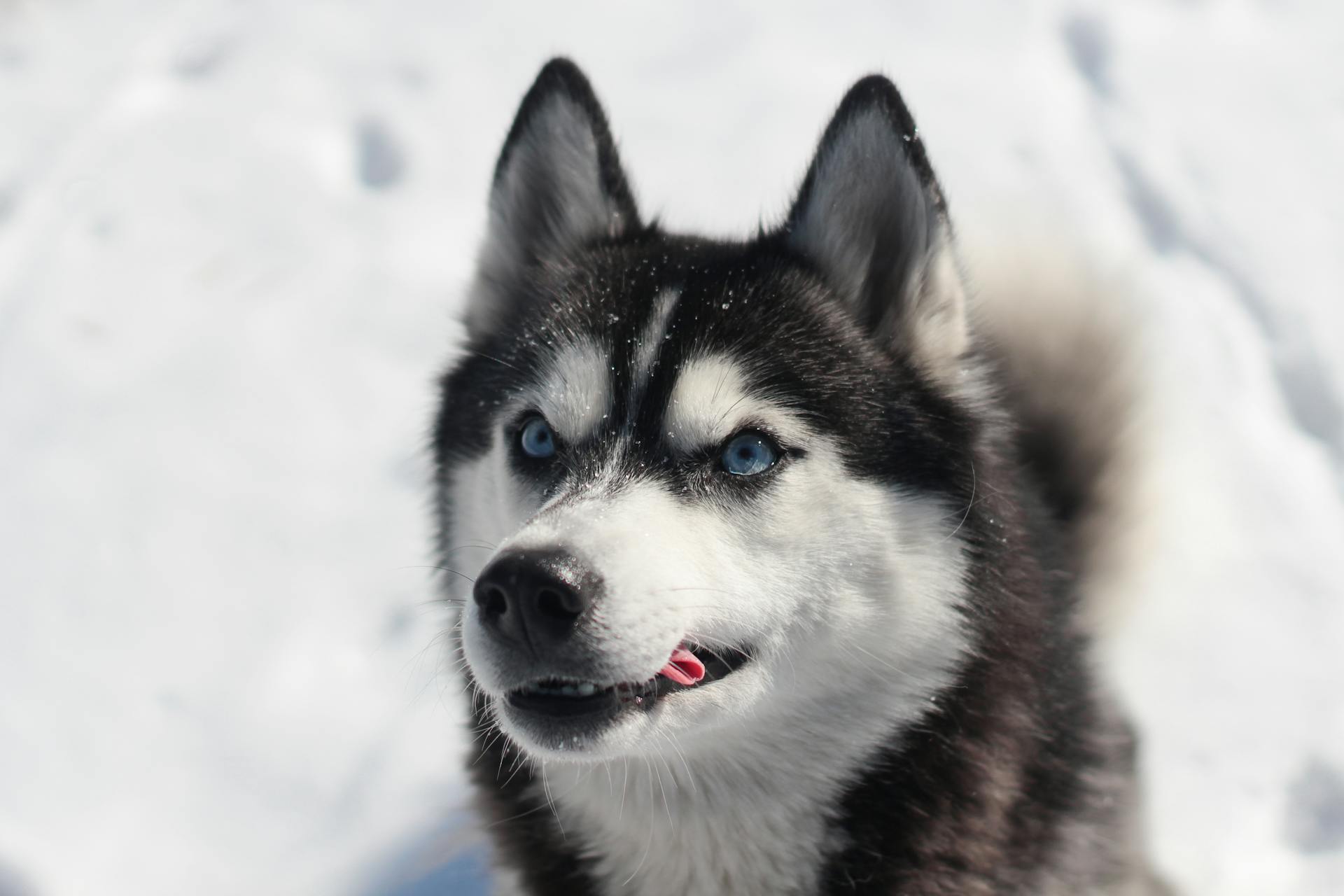
A Husky Lab mix can live up to 10-14 years with proper care and attention.
Their lifespan is influenced by factors such as genetics, diet, and exercise.
To keep your dog healthy, it's essential to provide regular exercise, which can range from 30 minutes to several hours a day, depending on their age and energy level.
A mix of physical and mental stimulation can help prevent boredom and destructive behavior.
Their thick double coat requires regular grooming, ideally 2-3 times a week, to prevent matting and tangling.
By following these simple tips, you can help your Husky Lab mix live a happy and healthy life.
Temperament & Intelligence
The temperament of a Husky Lab mix can be a bit of a mystery, but one thing's for sure: they're intelligent dogs that respond well to training.
Labradors are renowned for their gentle nature, which is why they're such popular family pets. Their intelligence and eagerness to please make them a joy to train.
Huskies, on the other hand, are highly energetic and can be quite stubborn at times. This mix can make them a handful if they're not put to work.
A Husky Lab mix will likely be somewhere between the extremes of their parent breeds, inheriting traits such as intelligence, energy, and loyalty. They'll be social and loyal due to their parents' histories of working closely with humans.
These dogs are super active, jumping up and down all over the place, and they don't bark aimlessly unless they're provoked.
Nutrition Requirements
Labskys are high-energy animals that need a nutrient-dense diet to stay active and healthy.
Good-quality dry food is ideal for them, provided it has a protein content of at least 25% and is free from filler ingredients.
You should aim to feed your Labsky around 80% dry kibble and 20% wet food or lean meats.
Make sure the first-listed ingredient is animal-based or that one is at least listed in the top three.
Feeding your dog high-quality food specifically formulated for high-energy breeds like Huskies is a great idea.
Splitting your dog's daily portion into two or three meals will help prevent bloat and eating too fast.
Be careful not to overfeed your Labsky, as they are prone to obesity and overeating.
It's essential to ensure they have access to fresh, clean water at all times.
Feeding smaller meals more often can help prevent bloat, especially if your dog tends to eat quickly.
If your dog is exceptionally active, you'll need to make sure they're getting food that can support their additional energy requirements.
Explore further: Carolina Dog Lab Mix
Exercise and Health
Exercise is vital for Husky Lab mixes, and they'll quickly become destructive and aggressive without it. Daily exercise is essential to their physical health and mental well-being.
They need a significant amount of exercise, with at least 2 hours of intensive exercise per day, preferably more. A short walk around the block just won't cut it for these high-energy pups! They'll love joining you on long hikes, jogs, runs, and interactive play in the backyard.
In fact, they need so much exercise that they can go into a deep depression if their needs aren't met. So, if you're a couch potato, a Husky Lab mix might not be the best fit for you.
Exercise
Exercise is crucial for a healthy and happy Labrador Husky mix. They need at least an hour to an hour and a half of exercise per day, and hopefully more.
A short walk around the block just won't cut it - they need a long jog or sprints to stay happy and healthy. Without enough exercise, you'll be looking at behavioral problems, such as ignoring commands.
If you don't meet their exercise needs, they can go into a very deep depression. This is not a dog you want to leave on the couch all day - they need regular, intense exercise.
Restrict exercise in the first few months when your pup is still developing, as too much exercise can cause issues while their body is growing. After 6-8 months, you can begin exercising your pup as much as they like.
They'll love joining you on long hikes, jogs, runs, and interactive play in the backyard. Just be sure to keep them on a leash unless you have a training collar on them, as they'll take off chasing anything and everything.
Common Issues
As you work on creating a healthy routine for your Labsky, it's essential to be aware of some common issues that can arise.
Labskys are prone to obesity, which can lead to various health problems if not managed properly.
Their diet plays a crucial role in maintaining a healthy weight, so it's vital to pay close attention to what you feed them.
Obesity can be inherited from their parents, so it's essential to be proactive in monitoring their diet and exercise routine.
Regular Vet Visits
Regular vet visits are crucial for your dog's overall health. Visiting the vet regularly simply helps to preempt any health issues before they even happen.
Going to the vet regularly also gives you the opportunity to catch minor health issues early on, which can be treated at home. Regular vet visits can help prevent more serious health problems from developing.
By taking your dog to the vet regularly, you can ensure they receive the care they need to stay healthy and happy.
You might like: Black Lab Mixed with Wiener Dog
Grooming and Care
The Husky Lab mix is a high-maintenance breed when it comes to grooming. They shed heavily, particularly during seasonal molting, and need regular brushing, vacuuming, and de-shedding to keep their coat in good condition.
You'll need to invest in a good vacuum cleaner and a de-shedding tool like the Furminator, and commit to daily brush-outs during molting season and weekly grooming at other times.
Labradors are prone to developing a "wet dog smell" and may need more frequent bathing, ideally once a month, while Huskies are fastidious about cleanliness and don't hold dirt and odors well.
Here are some health issues to watch out for in Husky Lab mixes, including PRA, bloat, cold tail, hip and elbow dysplasia, and cataracts.
The good news is that Husky Lab mixes have a relatively short health problem list, but it's essential to take extra care with their eyes and schedule regular check-ups with your vet.
To keep your Husky Lab mix looking neat and tidy, you'll need to brush and vacuum almost daily, especially during winter and spring when they shed heavily.
Huskador Grooming
The Huskador is a high-maintenance breed when it comes to grooming. They shed heavily, especially during seasonal molting, so be prepared to vacuum and brush them frequently.
You'll need a good vacuum cleaner that can handle dog hair, as well as a de-shedding tool like the Furminator. Daily brush-outs and weekly grooms are a must, not just to keep their coat in good condition but also to minimize the amount of hair left around the house.
Labradors are notorious for their love of water, which means they can develop that infamous "wet dog smell" quickly. They need regular bathing, ideally only once a month, to prevent stripping their natural oils.
Huskies, on the other hand, are fastidious about their cleanliness, and their thick coats don't hold dirt and odors like Labradors do.
Here are some potential health issues to watch out for:
The Huskador sheds heavily, so brushing and vacuuming are essential tasks. In fact, you'll need to brush them almost daily during winter and spring, and at least every few days during other seasons. Don't forget to vacuum frequently to keep your home fur-free!
Skin Irritation and Allergies
Skin irritation and allergies can be a real issue for Labskys. Labskys may suffer from allergies and skin irritation.
Using natural and safe cleaning and grooming products is a good idea to prevent skin irritation and allergies. This can help reduce the severity of allergic reactions.
Avoiding foods that may trigger allergies is also important for Labskys. The severity of allergic reactions varies from one dog to another.
Physical Attributes
A Husky Lab mix is a beautiful creature, and one of the first things you'll notice is their stunning appearance. Their size can vary between 20-28 inches in height and 60-100 pounds in weight.
Their coat colors are incredibly diverse, ranging from yellow, brown, white, gray, black, and red, and often featuring a mix of two colors. This is a result of the Labrador Retriever and Siberian Husky's genetic makeup.
One of the most unique features of a Husky Lab mix is their eye color, which can be brown or blue. But what's even more fascinating is that some of them can have heterochromia, where each eye is colored differently. This is a common natural phenomenon and doesn't affect their vision.
Their ears can be either dropped like a Labrador Retriever or upright like a Siberian Husky, depending on which parent they take after. Either way, they'll still require regular grooming to prevent matting and tangling.
Here's a quick rundown of their grooming needs:
- Daily brushing is a must to prevent matting and tangling
- They have a thick double coat that sheds heavily, especially during shedding season
- Regular nail trimming and ear cleaning are also essential
Overall, a Husky Lab mix is a stunning and unique companion that requires regular grooming and attention to stay happy and healthy.
Lifespan and Longevity
The Husky Lab Mix has a lifespan of 10 to 13 years. Some have been known to live up to 15 years with proper care.
Diseases like swollen eyes, dental issues, bloating, and arthritis are quite common in this breed. These conditions can be managed with effective care procedures.
With proper care, your Husky Lab Mix can live a healthy life.
Breeders & Costs
If you do want to buy a Husky Lab Mix, it's vital that you do your research. A Husky Lab Mix is not a recognized breed, so you won't find accredited breeders. You should make sure the breeder allows you to visit Mom and her litter in a home environment with access to a whelping pen. Breeders should get initial veterinarian exams and provide documentation of health screenings.
A healthy Huskador puppy can cost anywhere from $300 to $800 or more. The price depends on the breeder, parent pedigree, time of year, and age of the puppy.
Worth a look: Lab Weimaraner Mix Breeders
Training and Behavior
Training a Husky Lab mix requires patience and consistency, as they can be headstrong and stubborn at times. Positive reinforcement training is key, as harsh methods can damage the bond between you and your dog.
They are intelligent and eager to please, making them fast learners. However, they need regular mental stimulation and direction to prevent problem behaviors. This includes providing a wide selection of tough, interactive chew toys and redirecting their attention when they show interest in inappropriate items.
Their high energy levels mean they need plenty of exercise and training to keep them occupied. In fact, they are prone to developing separation anxiety if left alone for too long, so it's essential to provide plenty of socialization and interaction. With the right training and care, a Husky Lab mix can thrive and become a loyal and loving companion.
Temperament
The temperament of a Husky Lab mix is a fascinating topic. They can inherit the calm and affectionate nature of a Labrador Retriever, but also the high-strung sensitivity of a Siberian Husky.
Early socialization and training are crucial in shaping your dog's personality. You must be ready for your dog to take on temperament traits from either of the breeds.
Labradors are famous for being incredibly smart, exceptionally friendly, and eager to please dogs. This means they're generally easy to train, even for novice owners.
Huskies, on the other hand, are extremely energetic and driven, and they're not dogs that do well with apartment living. They also often have a high prey drive, so Husky mixes may not be best suited to living with other small animals.
Your Husky Lab mix will likely be intelligent, energetic, and loyal, but their temperament can be difficult to predict. They may inherit more of the laidback, affectionate, and calm temperament of a Labrador, or the independent, highly-strung, and stubborn personality of a Husky.
Labskys are also super active pooches, they will jump up and down all over the place. This means they require plenty of exercise and mental stimulation to keep them happy and healthy.
Overall, with the right training and socialization, a Husky Lab mix can make a wonderful and loving companion.
Curious to learn more? Check out: Pitbull Lab Mix Temperament
Training
Labskys are generally easy to train due to their Labrador genetics, but they can be headstrong and independent at times, so positive reinforcement is key.
Good training is essential for Labskys, who are full of energy and need plenty of socialization and mental stimulation to prevent problem behaviors.
You should start obedience training early, as both breeds are very smart and enjoy working, and without direction, they can develop separation anxiety and destructive habits.
Both breeds thrive on interaction, so they need regular one-on-one playtime and mental stimulation to keep them happy and engaged.
Huskies are notorious for their ability to escape, so they need a lot of training and a secure, high-fenced yard to prevent them from digging their way out.
The intelligence of both breeds means that any training you do will be extremely worthwhile, and they respond well to positive reinforcement training.
Labskys are eager to please and very food-motivated, making them a joy to train with the right approach.
Redirecting their attention to interactive toys and chew toys can help prevent destructive behavior, such as chewing on table legs or shoes.
With the right training and attention, Labskys can become well-behaved and loyal companions, but it does require consistency and a firm hand.
Additional reading: Husky Mix Dogs
Featured Images: pexels.com


